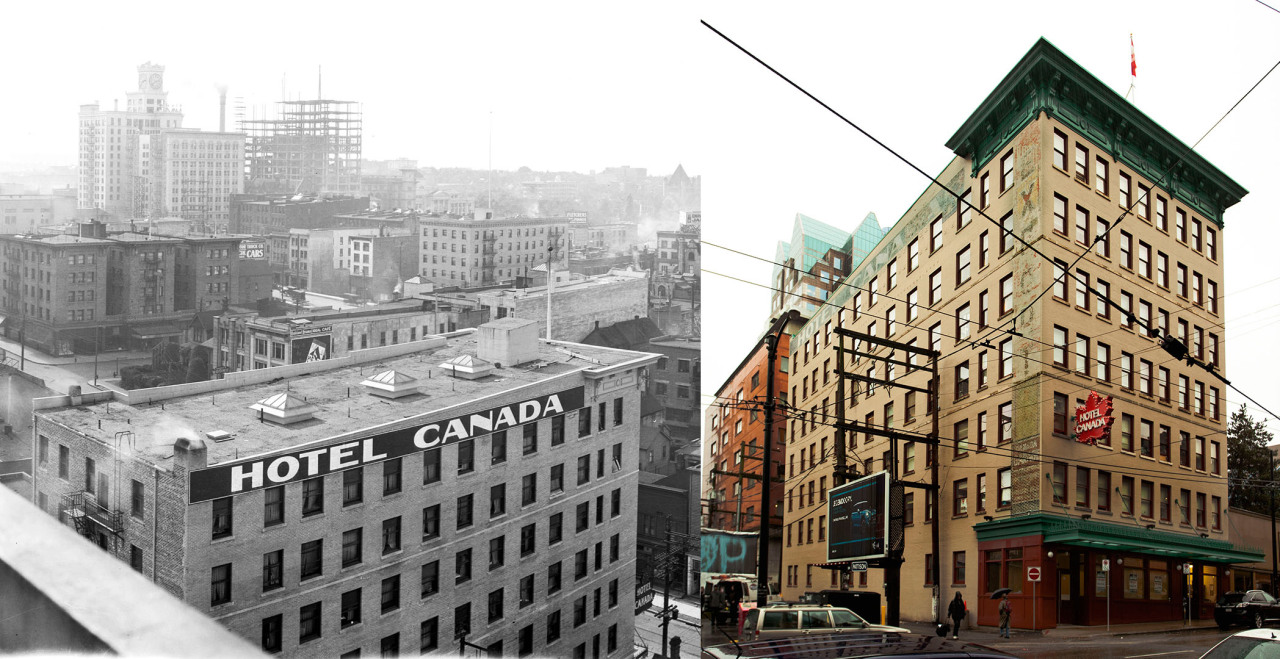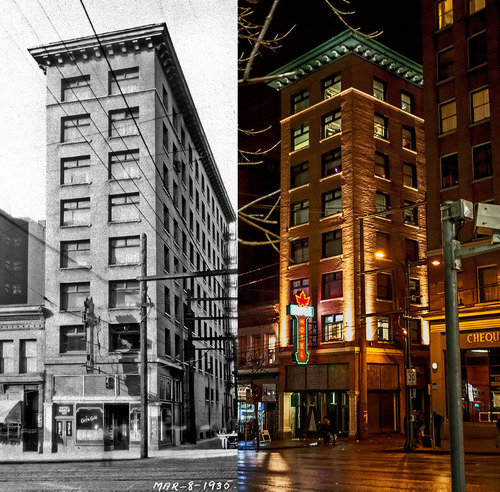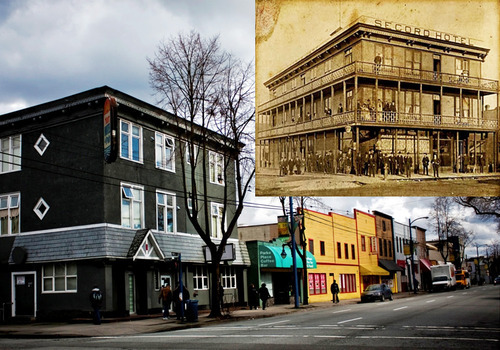 The old Marble Arch restored to its original look and name, Hotel Canada (1914 and 2015)
The old Marble Arch restored to its original look and name, Hotel Canada (1914 and 2015)
Vancouver’s Single Room Occupancy (SRO) hotels are an important part of our built heritage. Their numbers have seriously diminished over the years, but the survivors give the oldest part of town much of its heritage character. The majority were built during the boom years between 1908 and 1913 to accommodate the flood of seasonal workers coming into town, especially loggers from camps around the province. Though designed as temporary lodging, resource workers often settled in for good after they retired, and today SROs continue to serve as permanent affordable housing.
Years of severe neglect made these hotels derelict and barely habitable. BC Housing now owns many of them, and they’ve teamed up with the feds and private sector partners to restore thirteen of them to ensure they’ll be part of Vancouver’s streetscape for years to come. Collectively these buildings house 900 of the most marginalized Vancouverites. The restoration project is unprecedented in its scope and is being done in stages. Tenants are being temporarily relocated during construction and all have the option of returning to much more dignified digs than what they left.
 The old Washington Hotel on Hastings near Main restored to its original look and name, the Maple Hotel (1935 and 2015).
The old Washington Hotel on Hastings near Main restored to its original look and name, the Maple Hotel (1935 and 2015).
Wherever possible and practical, surviving heritage elements have been or will be restored or even recreated from the original building plans and old photos, such as the new cornice and sign on the Maple Hotel (formerly the Washington) just west of Main on Hastings. In some cases, long hidden artifacts have been uncovered. Several ghost signs on the side of Hotel Canada include the original hand-painted sign advertising the hotel and another from its days as the Marble Arch, and one that says “Export,” likely a remnant of an old cigarette ad. The Hazelwood Hotel, a longtime Hastings Street blemish, will have its entrance opened up and flanked by the original, long-buried doric columns.
Some of the SROs are too far gone to get the full heritage treatment. It wasn’t long ago that the Marr Hotel on Powell Street was a contender for being the most unruly and decrepit SRO hotel in the Downtown Eastside. In contrast, Angus Secord built it in 1890 as a booze-free, family-friendly hotel and “a quiet, cheerful, comfortable residence.” Shoddy renovations, neglect, and abuse over the years have left virtually no heritage features to restore, so the renovations will be less elaborate than some of the other buildings.
 The Marr Hotel on Powell Street. The inset photo shows it when it was brand new and named the Secord Hotel (1890 and 2011). This SRO is being renovated, but those groovy wrap-around balconies won't be making a comeback.
The Marr Hotel on Powell Street. The inset photo shows it when it was brand new and named the Secord Hotel (1890 and 2011). This SRO is being renovated, but those groovy wrap-around balconies won't be making a comeback.
I normally focus on social and cultural history rather than heritage conservation, but these SROs often make cameos in stories I come across. In Vancouver Confidential, I wrote about some proto-Cold War intrigue going on in the Globe Hotel, or Tamura House, in Japantown. When boxing legend Jack Johnson came to Vancouver with a white woman in 1909 shortly after becoming world champ, the Dominion Hotel was the only one in town willing to rent to the mixed race couple. Tommy Chong came here in the 1950s to pursue a music career with his R&B band and found his first Vancouver home at the Hazelwood, located just a few blocks from where he later stumbled into his true calling as half the comedy duo Cheech & Chong. More infamously, the Broadway Hotel — now called the Sunrise and soon to revert to its original name, Hotel Irving — was such a notorious drug hotspot in the 1950s that Hastings and Columbia was known across Canada simply as “The Corner,” a dubious reputation that has since drifted over to Main and Hastings. Similarly, the Maple Hotel changed its name in 1935 to disassociate it from the nefarious reputation of the previous owner, Joe Celona, who ran it as a brothel. Its old name and look have now been restored.
Renovations at all thirteen SROs should be complete by 2016 at a total cost of $143.3 million.
Thanks to architect, engineer, and heritage preservation consultant Barry McGinn for details on the SRO project.
Historical photo credits: Hotel Canada (1914) by WJ Moore (cropped), City of Vancouver Archives #PAN N216; Maple Hotel (1935), CVA #Hot N65; Secord Hotel (1890), CVA #Hot P85.


